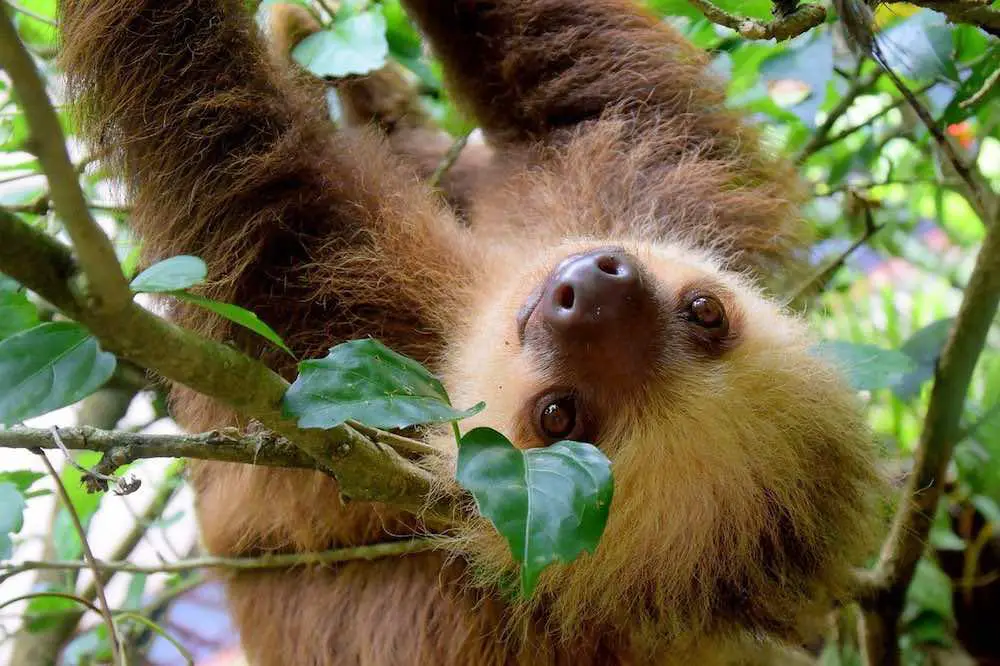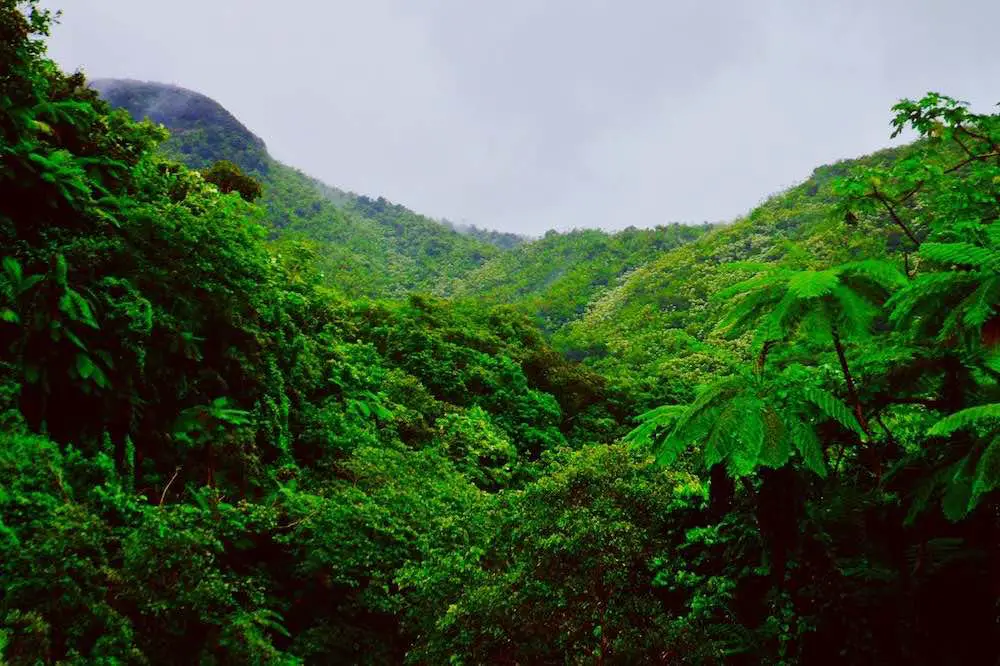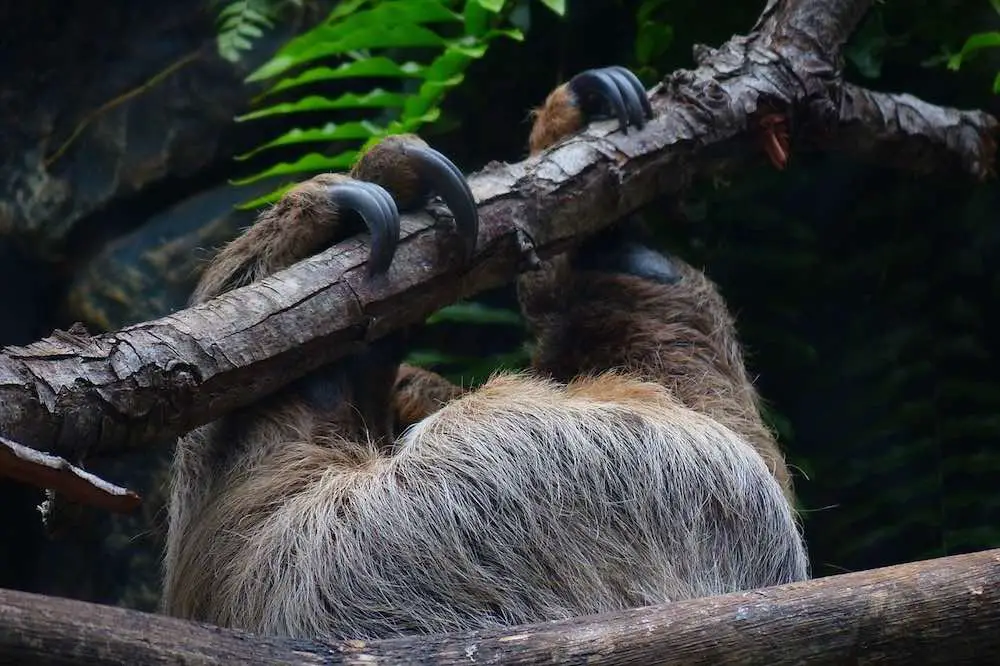
I guess most people know that sloths live mostly in rainforests. But you may not know that this was not always the case. Hundreds of years ago giant sloths called ground sloths roamed further afield. So how do sloths adapt to the rainforest, and why is this such a good place for them to live?
Whilst writing about sloths I’ve found out tons of information, including the answer to this question.
So then how do sloths adapt to the rainforest? Sloths adapt to the rainforest by living high in the trees, keeping them safe from predators. They can feed entirely on their leaves. Sloths move slowly at night, and camouflage with green algae. They have longer arms than legs, to help them climb. They have long claws to hang in the trees.
So the above is the short answer to how sloths adapt to the rainforest environment. I’ve gone into some more detail about this below, plus some extra information about their toilet habits, stomachs and extra vertebrates. Read on to find out more.
Contents
How Do Sloths Adapt To The Rainforest?
Sloths are well known in the animal kingdom for their incredibly slow moving speeds. They are thought of as lazy, and in fact ‘sloth’ is one of the capital sins, often referring to laziness or an omission to do one’s duties.
But sloths are the way they are for a particular reason. Darwin’s theory of evolution takes in to account adaptability traits that sloths have developed in order to survive in the places that they live.
This ability to adapt to their natural surroundings means sloths have been able to survive in their natural habitat. For sloths this is largely the rainforests of South America. The different types of sloths can be found in a vast array of countries, and they all live in forested areas.
Now I’m not going to go into a huge amount of detail about all of the different types of sloths in this post. We can assume that I am talking about sloths in general with the information I give here.
Very briefly, sloths are split into two different families or genera. These are the two-toed sloths and the three-toed sloths. Both families of sloths have three toes on their hind limbs.
It’s just that two-toed sloths have two of these on their forelimbs, and the three-toed sloth has three. This is just one of the many differences between two-toed and three-toed sloths.
Between these two families of sloths, there are six species of sloths, and 12 subspecies. The 6 species are:
- Choloepus didactylus (Linnaeus’s two-toed sloth)
- Choloepus hoffmanni (Hoffmann’s two-toed sloth)
- Bradypus torquatus (Maned three-toed sloth)
- Bradypus tridactylus (Pale-throated three-toed sloth)
- Bradypus variegatus (Brown-throated three-toed sloth)
- Bradypus pygmaeus (Pygmy three-toed sloth)
Now what many people don’t realise is that there are also several other extinct species of sloths, that once existed but don’t anymore. The ‘ground sloth’ is a collective term for all of the extinct species of sloths.
These sloths were much larger than the extant (the opposite of extinct) sloths that we see today. As you can imagine with that name, they were not tree dwellers but lived on the ground.
They were often hunted by humans on the ground, which is one of the many reasons they did not survive, unlike their tree-dwelling counterparts.
So let’s take a look at some of the sloth’s adaptations that have allowed the tree-dwelling sloths to survive in a world where the ground sloths could not. Many or almost all are interrelated, or lead on from the next one.
Is Living In Trees An Adaptive Sloth Trait?
The most obvious answer to how do sloths adapt to the rainforest comes is the place they choose to call their home. I have called sloths tree-dwellers a couple of times for a particular reason.
There are a number of predators that will choose to hunt sloths, and the trees provide a good amount of protection for sloths from these.

Sloths have been able to adapt to the rainforest by using the forest itself as a form of protection. Not only this, but they have adapted over time to be able to live on and survive with the food provided largely only by the trees they live in. Pretty clever.
We’ll talk a bit more about their relationship with the trees as we talk about some more about the sloth’s adaptations to the rainforest. It’s really impossible to talk about the adaptive traits of a sloth without continually talking about the trees! They do live in the rainforest after all!
How Do The Sloth’s Claws Help Them Survive In The Rainforest?
Just as the sloth chooses to stay in the trees because they offer shelter and food, so has a sloth’s body adapted to it’s surroundings too.
Regardless of whether we are talking about the two-toed or three-toed sloth, sloths have extremely long claws. Sloth’s claws can grow to between 3 and 4 inches (8 to 10 cm), which is incredibly long.

Due to the fact they need to hang around in trees a lot of the time, these claws are long and curved. The curved shape of them means they can easily grab around the branches of trees to lock tight and keep them safe there.
These claws do offer some limited protection against predators in the rainforest too. Sloths are not fierce or violent, and won’t attack unless provoked into defending themselves. So if you ever come across one, don’t worry. Sloths won’t attack humans unless provoked by one!
How Have Sloth’s Limbs Adapted To The Rainforest?
A sloth’s limbs also play an important part in how sloths adapt to the rainforest. Again this is closely related to their life in the trees. Sloths can barely walk on the ground, and in fact have to drag their limbs along with them.
Their ancestors, the ground sloth, could walk on the ground, albeit not hugely quickly. But they could still walk. For a sloth, their limbs are used mostly for climbing and hanging in trees.
It’s not too often that you come across an animal that has longer arms than it does legs. This is the case for the sloth. A sloth’s arms are much longer than it’s legs, and this has adaptive purposes also.
Sloths use these arms to climb up and down trees, and between branches. They also use them for hanging upside down in trees for several hours.
The fact that over hundreds of years sloths have adapted their bodies in this way means that they have a greater chance of survival in the rainforests.
Is A Sloth’s Diet An Ideal Rainforest Adaptation?
A sloths diet plays a large part in answering the question how do sloths adapt to the rainforest. The vast majority of a sloth’s diet is made up primarily of leaves. In fact there really is no need for them to supplement their diet with anything else.
Some sloths will eat flowers or small fruits, or even small insects if they are about and perhaps leaves are in shorter supply. Leaves in the rainforest are full of toxins, partly to prevent too many creatures from eating them.
Sloths have a unique digestive system, that sees their stomachs compartmentalised into four chambers. These chambers are full of different bacteria that work to break down the leaves.
It can take anywhere between 30 and 50 days for sloths to fully digest these leaves. This is one of the reasons they often prefer younger, softer leaves. They are easier to digest.
Are The Sloth’s Toilet Habits Adaptive?
I find the sloth’s relationship with trees in their natural environment to be so interesting. Being on the ground leaves them vulnerable to attack. So they spend all day and night hanging in trees. The same place they can get all of their food.
Their stomachs have evolved to be able to process and digest this food, and this takes a long time to do. This therefore means that they do not need to go to the toilet anywhere near as regularly as we do!
How does this benefit the sloth? Well it helps to keep it safe. Sloths climb down from their trees to go to the toilet. As you can imagine, the climb down and then back up is a long one, fraught with dangers.
A sloth’s best defence against being attacked is to stay as still as possible amongst the trees. If they climb down from here they risk being spotted. Also, while they are on the ground, it is very difficult for them to be able to protect themselves.
Sloths only need to come down to use the bathroom once every 7 to 10 days. Can you believe that? By the time they get down there, a sloth’s bodyweight can be made up of roughly 30% waste.
They go to the toilet at the foot of the tree they live in, providing the tree with fertiliser, made from the leaves of the same tree. This is one of the many ways that sloths help the environment.
You can really see the full picture of how sloths have adapted to the rainforest, and it’s really very smart. Living in trees, hiding and staying safe, the food they eat, and their toilet habits are all interlinked. They all serve to keep a sloth safe so it can carry on living and adapting.
The Sloth’s Slowness Is Not Laziness
Sloths are slow creatures right? We all know this. In fact a sloth moves at an average speed of 4 metres per minute in the trees. If they are under attack, they can move the needle to 4.5 metres per minute, but this is outrageously slow. Sloths can swim much quicker than this though. They can swim roughly 13 metres per minute!
On the ground sloths can only move around 1.5 metres per minute. Obviously this varies between breeds, but this seems to be a reasonable estimate of average sloth moving time.
The graph below shows how this compares to some other land animals!

This is perhaps one of the many reasons that the ground sloth did not survive. So although this is can be seen as a negative, sloths can also use this to their advantage when staying safe.
Sloths move so slowly in part due to their slow metabolism, which is related to what they eat and where they live. But this slowness can be an advantage too.
The best protection a sloth has against predators is to stay camouflaged and still. That way they are safe from animals such as margays, that can climb trees to hunt them, and eagles such as harpy eagles and crested eagles that can swoop in to get them high up in the canopies.
So staying still, and moving slowly in the trees is actually a sloth adaptation that serves to keep them safe in the rainforests. It’s not that sloths are lazy. They just need to move slower to preserve energy, and to stay safe.
A Sloth’s Fur Is Hugely Protective
A sloth’s fur is fascinating! It is yet another one of the sloth’s adaptations that have helped it to adapt to the rainforest. What happens in the rainforest a lot? Yeah, you guessed it. It rains!
Sloths have an outer layer of thick fur, and then another layer underneath. This outer layer of fur actually grows in the opposite direction from what you would expect.
So rather than growing down towards their feet, it grows in the opposite direction. This is because sloths spend so much time hanging upside down.
When it rains, and they are hanging upside down, the direction of their fur allows the rainwater to run down and cascade off the sloth to the ground below. This stops them from becoming soaked through with rainwater.
The sloth’s fur is coloured in such a way that it helps them to remain camouflaged in the trees in which they live. Although there is some variety between the different species, they are all colored in such a way to blend in with their surroundings.
Another fascinating thing about a sloth, and about it’s fur in particular, is the odd green color you can often observe on the sloth’s fur. This comes from algae growing directly on the fur of the sloth.
Due to the fact that sloths move very little, and they live in hot and humid conditions, algae can be found growing on their fur. This serves two purposes really.
The first is that it helps them to blend in with their surroundings even more. What else is green? The leaves on the trees around them. Sloths are not as daft as they look!
Secondly, within this algae and growing in the sloths fur live a number of different creatures, such as beetles, moths and flies. Sloths have a whole ecosystem growing in their fur.
They are literally helping other rainforest creatures to grow and survive. These in turn can feed other animals, and sometimes the sloths too.
This also ties in with the toilet habits of the sloth. When they go down to use the toilet, the waste that they create makes an excellent place for some of the creatures living within their fur to lay their eggs.
The Sloth’s Sleeping Habits Are An Adaptive Quality
Believe it or not a sloth’s sleeping habits also help us in our search for the answer to the question how do sloths adapt to the rainforest. Yes it is true that sloths sleep a lot.
I wish I could sleep as much as they do. Whilst some of them are diurnal, meaning that they can come out during the day, most of them are nocturnal.

Coming out at night serves a couple of purposes really. Firstly, they are safe from any predators that are diurnal, as quite simply they will be sleeping.
Secondly, moving slowly under the cover of darkness makes it even more difficult for other nocturnal creatures to spot them and attack.
The Sloth’s Head Turning Abilities Have A Purpose
Whenever I think of sloths, I think of them turning their head in almost a comical 360 degree rotation. This is not just some fictional cartoon sloth portrayal. Sloths can turn their heads between 270 and 330 degrees, depending on the species.
This is due to the amount of vertebrae sloths have. Two-toed sloths only have five cervical vertebrae, where all other mammals have seven of these. The only exceptions to this are the three-toed sloth and the manatee.
Three-toed sloths can have up to nine of these cervical vertebrae. This allows them to turn their head much more than other mammals. How is this a useful adaptation to help them survive in the rainforest?
It helps to keep theme safe of course. If they can’t move quickly when predators are approaching, they need to be able to spot dangers much quicker.
Being able to turn their heads more is a definite advantage, and helps us to answer the question how do sloths adapt to the rainforest.
Summing Up
So there you have it. The answer to the question of how do sloths adapt to the rainforest is a complex and interlinked one.
They have a relationship with trees whereby they are able to keep them safe from predators, camouflaged in their leaves. They are also able to live entirely on the leaves of these trees.
They digest them very slowly, meaning they only need to go down to the toilet once every seven to ten days, keeping them out of harms way.
They have well adapted bodies, with longer arms than legs to help them climb. They also have long curved claws to help them hang in the trees.
They have fur that protects them from the elements such as rain, and they grow green algae on this to help keep them camouflaged.
Some sloths can turn their necks almost 360 degrees, allowing them to check for predators.
Sleeping during the day also keeps them safe and away from many predators.
I hope the information in this article has been useful. If you would like to ask a question, or add anything to this article, then please leave a comment below.

